What does outdoor education and place-based learning look like right now? One of the recommendations from leading health officials is to conduct classes outside. But what if you’ve never done that before? What if you could use some pointers? How are other educators tackling this topic? And why should we keep taking students outdoors, even when the pandemic is over?
We sat down with a panel of educators from around Vermont, who provided some advice, pointers, and stories from what they’ve found works for outdoor education.

This article was originally presented as a webinar in the 2020-2021 Tarrant Institute Professional Learning Series.
Resources from the webinar are available here.
1. What is place-based education?
Aimee Arandia Østensen
Shelburne Farms
Shelburne VT
“My name is Aimee Arandia Østensen, and I work as a professional learning facilitator in education for sustainability at Shelburne farms and Shelburne Vermont. I’m currently coming to you from the ancestral, un-ceded and contemporary lands of the Haudenosaunee people of New York State.
What is place-based education? So there is no singular definition of place based education; it’s an evolving practice and approach.
But for this session, we’re going to use this definition from the Promise of Place website:
“Place-based education (PBE) immerses students in local heritage, cultures, landscapes, opportunities and experiences, using these as a foundation for the study of language arts, mathematics, social studies, science and other subjects across the curriculum. PBE emphasizes learning through participation in service projects for the local school and/or community.”
We find ourselves in an interesting situation right now, where schools and teachers are needing to reinvent how we teach to meet the needs of this COVID-19 crisis. Many schools and teachers are being encouraged to use the outdoors as a site of learning in a time when we need to social distance. While this is a great solution for this crisis, it’s also a great opportunity for many teachers to connect to the practices of place-based education. The benefits go far beyond solving the challenges of social distancing and teaching through this global pandemic. While it does meet the needs of the moment, it can be an enduring piece of our education practices.
I want to take a moment to acknowledge that outdoor learning and place-based education are related and separate practices.
One can be an outdoor educator and not consider place-based education much, or one can be a place-based educator and use the outdoors in a limited capacity. As you see in this graphic, there is an overlapping space between outdoor learning and place-based education for the purpose of this discussion:
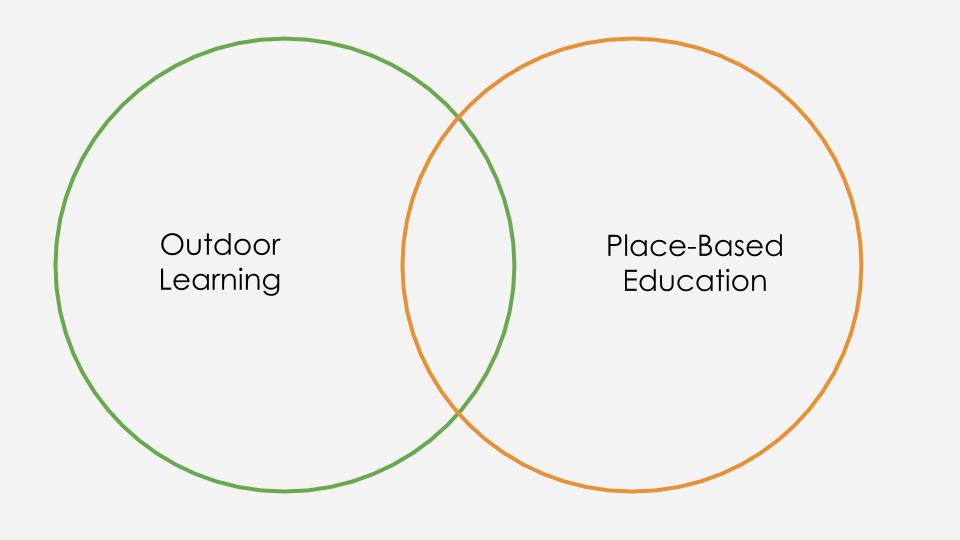
We want to expand that overlapping space and explore that overlapping space where outdoor and place-based education are happening simultaneously.
Where does place-based education happen?
This is a graphic that we use at Shelburne Farms:
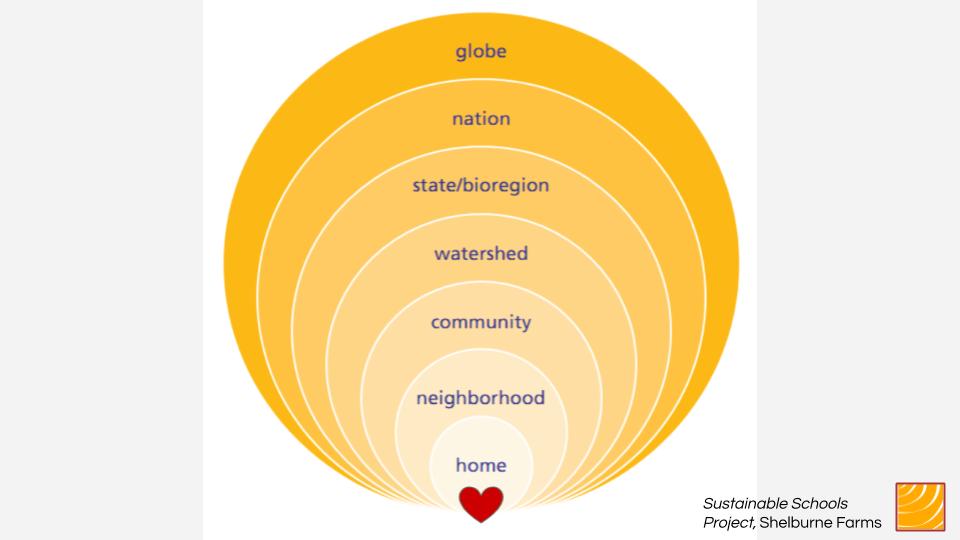
Place-based education happens everywhere.
It begins with the individual connecting oneself to their space and their environment and their neighborhood.
And as students get older, they might be exploring wider realms of place, from their community out to the globe. There are unending answers to the question of where place-based education happens, but in order to do it, we need to start looking beyond the classroom and beyond the school walls. To explore connections to our curriculum, and what possibilities for taking action and learning exist out in the world.
There is no singular process for place-based education, but we like to consider how we could begin with wonder and carry students through to action by layering inquiry with knowledge, understanding a sense of responsibility, and caring. We hope that students develop a deep, caring relationship with the places they inhabit and the relationships that exist in their surroundings so that they can take informed action right now as students, and in the future as adults– practices and outcomes that we hope stick with all of us. Place-based education helps students learn to take care of the world by understanding where they live and taking action in their own backyards and communities.”
2. Integrating the middle school curriculum outside.
Cliff DesMarais
Flood Brook Union School
Londonderry VT
“My name is Cliff. I teach at Flood Brook School in Londonderry, Vermont. My pronouns are he, him and his, and I’m coming to you from the heart of the occupied Abenaki territory in Southern Vermont.
I’m gonna just tell you a little bit about my story of outdoor Ed down here at Flood Brook School to begin with.
One of my core values is that students really need to feel ownership if they’re going to have any passion for learning.
So I really like to think about the year in terms of cycles; it plays really well into what we teach. When the blackberries are starting to ripen, that’s the time of the summer where I start to think about like: what do I have to get going? What’s going to happen this year in school?
Then here we are a little bit further and it’s apple season. The cider apples are coming in, and it’s kind of the time where you started to see the things coming on the vine and the apples are going out. You’re finally seeing the fruits of your labor. That’s kind of the metaphor of where I’m at right now.
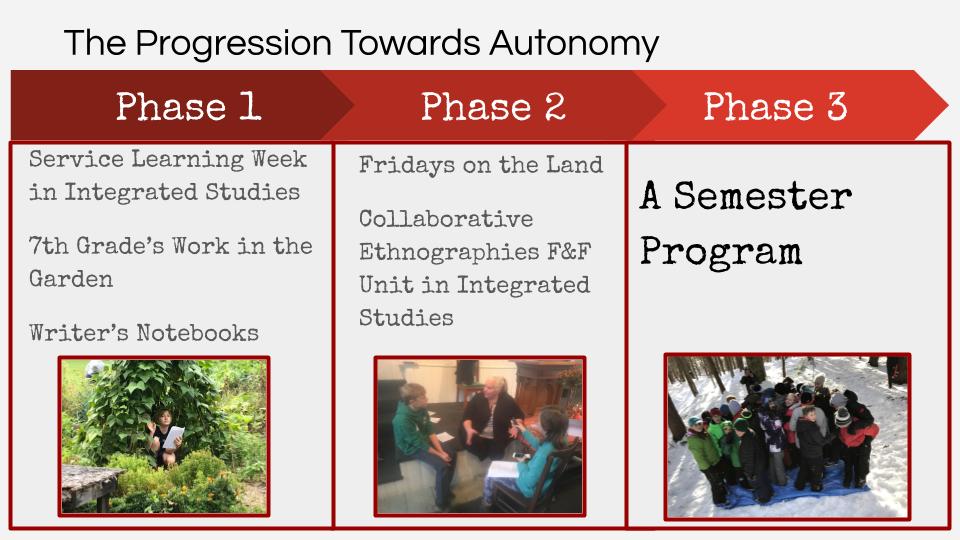
Here at Flood Brook, we have seen a few different phases of outdoor education.
We started with some service learning in our integrated studies program. Oh, and I teach social studies here at Flood Brook. In the seventh and eighth grade. I’ve been a sixth, seventh and eighth-grade teacher in language arts, social studies, and what we call integrated studies, which is a combination of science and social studies taught through the project baselines.
My seventh graders who I had for language arts, would start with work in the garden with our science teacher. They started by doing writer’s notebooks outside. And we saw this to be a really developmental approach for where our kids were at in seventh grade. And that it would benefit the entire program if we really doubled down on it.
So in phase two, we spent about two years moving out and spending our time out on the campus.
We’ve got nearly 24 acres here at Flood Brook. It’s about half forest and half school, with open fields and pastures. And we took a Forest Friday approach and started what we call “Fridays On The Land”, where students are taking control of some of the stewardship of our campus. They’re working on trail systems, they’re working on the garden help our, our farm to school program. Those kinds of activities.
We also use the social studies classroom for collaborative ethnographies in outdoor education.
We had an integrated unit in our science and social studies class where we connected with a few other schools and some of the local nonprofits here and started telling the story of the people in our place.
And the end goal is that we’re looking to develop a semester-based outdoor education program here. Either a rotation through our middle schoolers or through our entire consolidated district. This is where we’ve been and that’s where we’re going. We focus a lot on character development and how kids socialize both with our classroom community and with the larger Londonderry community. We do a fair amount of social-emotional learning and focus on the skills there and everything.
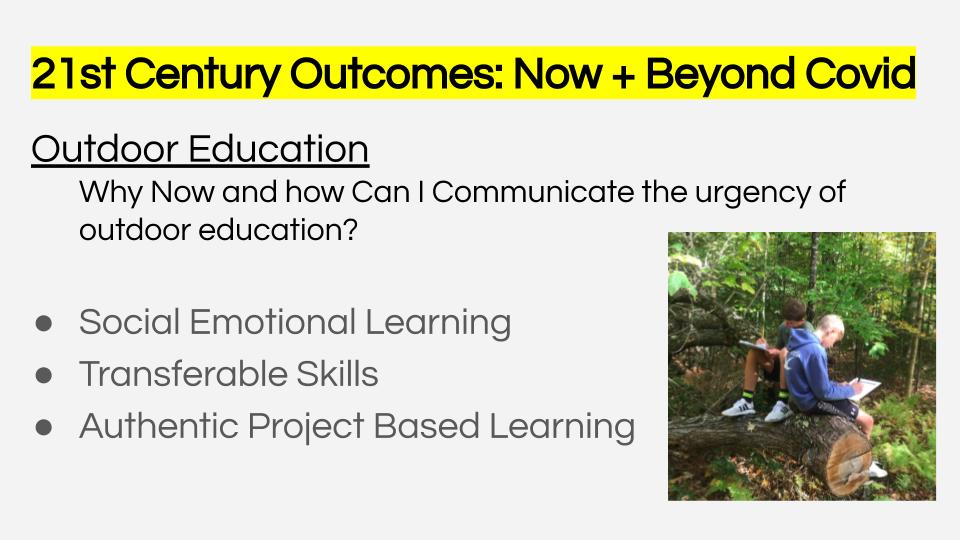
And our outdoor ed work uses project-based learning, and really a large focus on transferable skills.
So while we have social studies and science standards that our proficiencies are geared towards, we also have learning scales for them. We spend a lot of time talking about how this shared experience can contribute to a kid’s ability to clearly and effectively communicate. To problem-solve, to be an engaged citizen.
So when they’re out on the trails, they get to problem-solve and try to figure out what can we do to improve the land for who’s going to be here next, but also to be an active participant. For instance, we had some students here who had a tree right across our main lane of trails and they wanted to move it.
So it got bucked up with a pulley system.
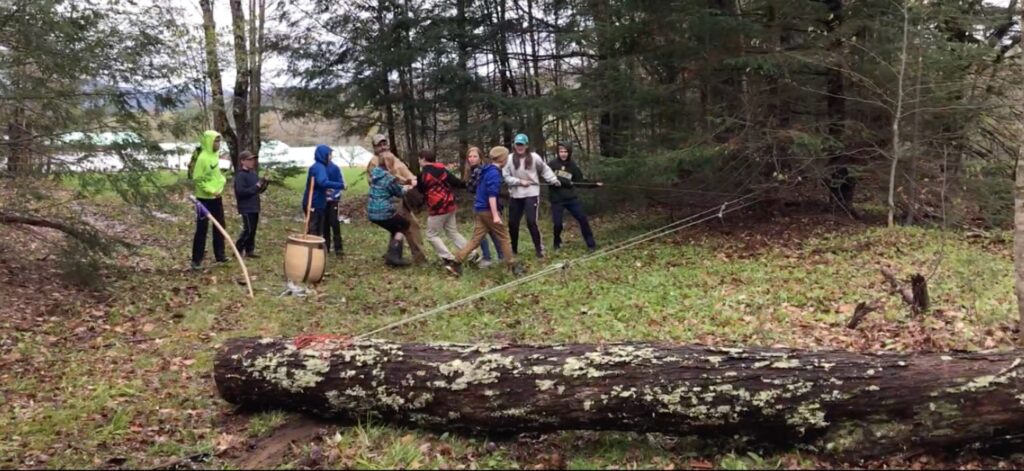
And we had a full advisory’s worth of six, seventh and eighth graders They used a three-to-one system to learn about mechanical advantage, and they hauled that massive sugar maple right out of the way.
Then, of course, we not only got to use that sugar maple as a balance beam for team-building, but it actually became lumber that was milled at one of our local sawmills, and then got used for student projects. Problem-solving with authentic, transferable consequence.
Which brings me to the here and now.
Right now at Flood Brook, we have a group of kids who are here in what we call Phase One. And as we slowly bring kids back to the middle school, that’s only six kids. But most of their friends are remote learning and there’s this feeling of parts of our community getting different things.
Our Phase One learners masked up and worked on benches. They made some out of wood from that maple tree we pulled off the path. They’re getting to give back in addition to having a safe place, if their parents are essential workers, or if a school is the best place for them to learn. They’re kind of getting a little bit of a taste of what the rest of our students will have in outdoor education when they get back here. We’re all trying to get back outside in a deliberate, intentional manner.”
3. Fire rings and transferable skills in the White River Valley
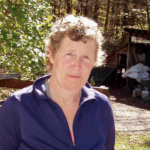 Bonna Wieler
Bonna Wieler
White River Valley School District
Bethel VT
“I have two pods of middle-schoolers at the Bethel middle school: a Monday / Tuesday group and a Thursday / Friday group. Everybody else has one pod and does academic work remotely. But I just get kids outside. We’re looking at the biodiversity of life: you can touch anything that’s living and do something with it.
I’ve been doing this with Bethel, teaching outdoor ed for 30 years now. We really want to get kids connected to themselves and to the outdoors and as much nature as possible. We want them not to be afraid of it and to look at it for their solace, you know?
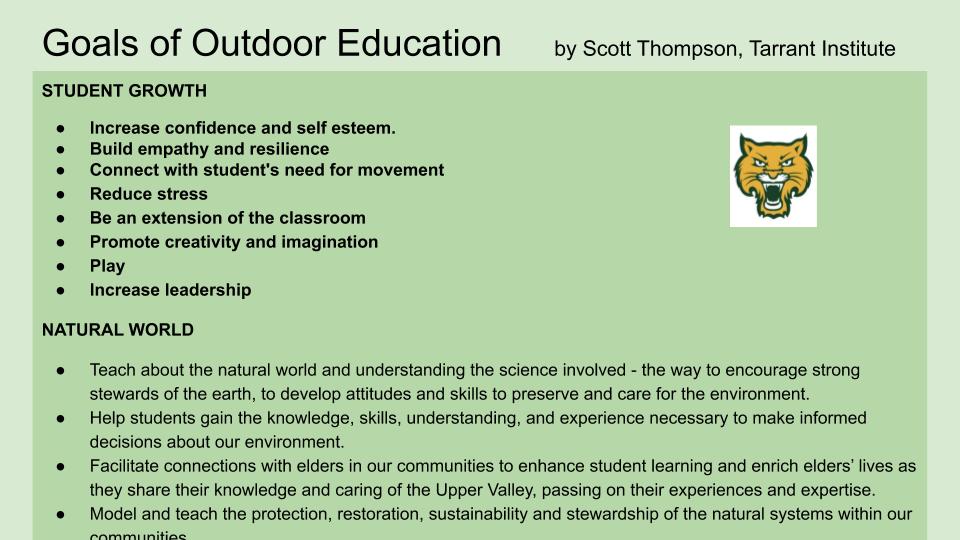
We have a system where we’ve got “sit spots” or magic spots, so to speak. The kids will take their journals and their pencils and go up and find the spot they want to hang out in for five to 15 minutes every day that we can.
And they come back different.
They get time to sit with themselves without a big rush. Without the pressure of social stuff going on amongst them. Cause they’re in their own spot.
And then they grow.
They get together and they share that we’re helping with their self-esteem. And I’m finding that every kid who was once way behind or way out in front — and everyone in between — now has some leadership skills that I’m finding we can help nurture.
You watch them very closely when you teach a new skill or get connected with some kind of content area.
You watch them because they’ll spark.
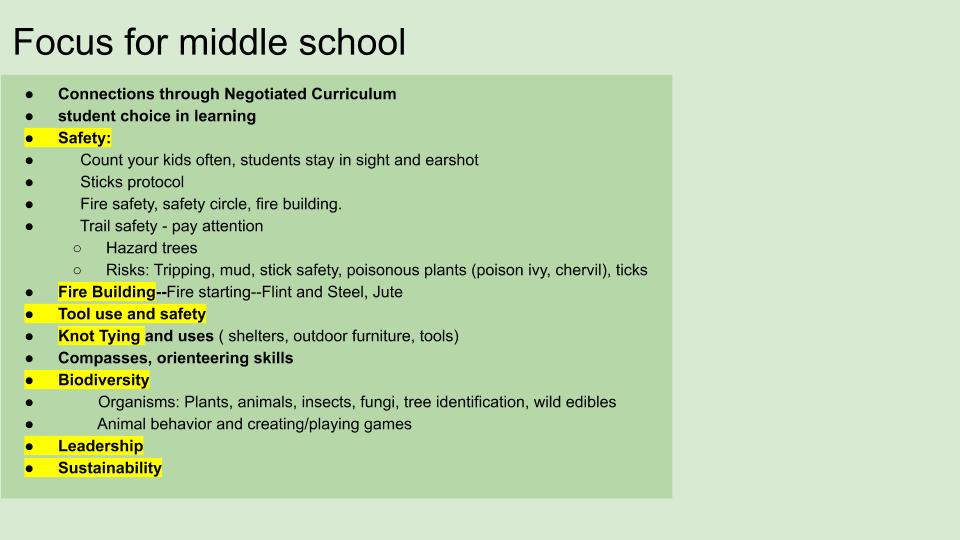
Right now there’s a burn ban in Bethel. But we’d already started building our fire pits.
They go to the woods and they’re developing their own campsites. And part of that, the biggest part, of course, is safety. So anything that has to do with fire has to be extremely safe. We had been putting more than three inches of gravel underneath where there would be a pit. We had been putting a screen over it and surrounding it with rocks or bricks, and having water on hand. But right now we’re not doing any fires because I want the children to really get it; I want them to get that burn ban, and why it’s in effect, even though we did all this safety stuff in advance.
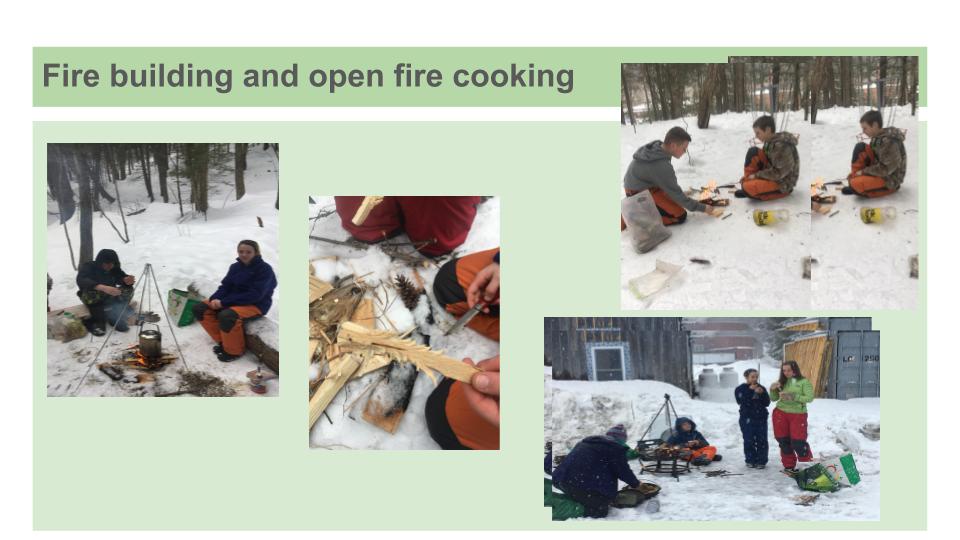
Now, I want to talk a little bit about when Phase 3 for Vermont (.pdf) comes around, where kids will be in the building.
I personally will still be out of the building.
I’m having them send me kids and the teachers, if they will come. We’ll still go back into the woods and be working on our skills and our perseverance and our fortitude, with biodiversity as a topic. But we’ll continue with the negotiated curriculum in outdoor education that we’re doing at this school. The kids come up with what they want to study in their pods. If all the kids have something about animals, for instance, they ask each other: what do they have in common?
Finally, here’s a little bit about transferable skills.
Last fall, we were building a trail. We worked with the Maine Guide Association Certification program.
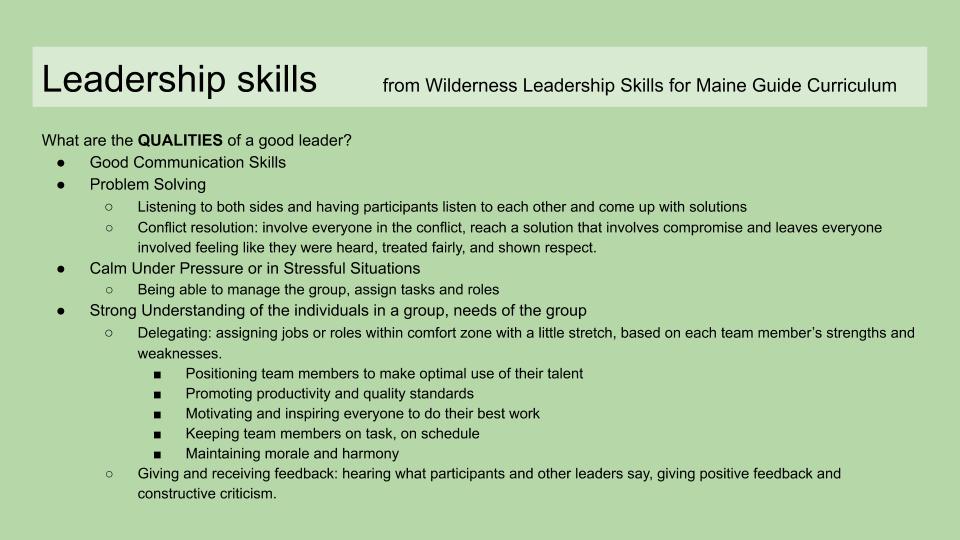
There’s a middle school and high school program and the high school it’s based out of Maine. Anybody who’s going to be a Maine guide has to pass a certification. But now they’re training the kids, the middle and high schoolers very intensely with very directed and thorough trainings. How to lead trips, and how to be a leader as well as how do you do all the skills and take care of other people as well. So we’ll keep doing that work as well.”
4. Growing an outdoors program at the high school level
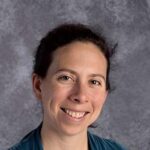 Annie Bellerose
Annie Bellerose
Champlain Valley Union High School
Hinesburg VT
“Like Cliff, I’m a humanities teacher. And I come from a background in outdoor education and farming. And this has really just worked for me at the high school level. And it’s very much a work in progress and very much an experiment. But I wanted to talk a little bit about the strengths and challenges of working with a high school age population. I don’t know how many folks in our group right now are working with 9 – 12. And then also just about kind of how to really think about designing curriculum that’s created with place in mind. It’s not: completely moving your English or social studies class outside. It’s more: is place really integrated into what you’re doing?
I’m finding this whole outdoor, place-based initiative is really helping kids develop their own leadership skills and become self-confident, and wise, and caring, and a community member in a way that I don’t see in the classroom.
I think we’re on the right track.
All the teachers are happy.
The kids are happy.
To the point that I worry about them going back in doors.
They’re developing their own projects of what they want to learn and fitting everything else into that.
Of course, getting everybody outside is amazing, no matter what that looks like. In teaching outside, I try to make it as low tech as possible. No screens, essentially. And some of the research and, and film watching is done outside of our class time together. But when we’re present, we’re really present.
Like, yes, we have those folks who were wearing flip flops in December. But I would say for the most part it’s a really wide variety of personalities and backgrounds. Students are really thrilled to be outside.
Often, particularly at the high school level, there’s sort of this idea that you get off the bus or out of your car and you immediately go into the building and you’re there all day. We don’t really come outside. Then maybe you go to sports practice, but that’s pretty structured. But so this idea of play and exploration, and being calm outside I think was really novel.
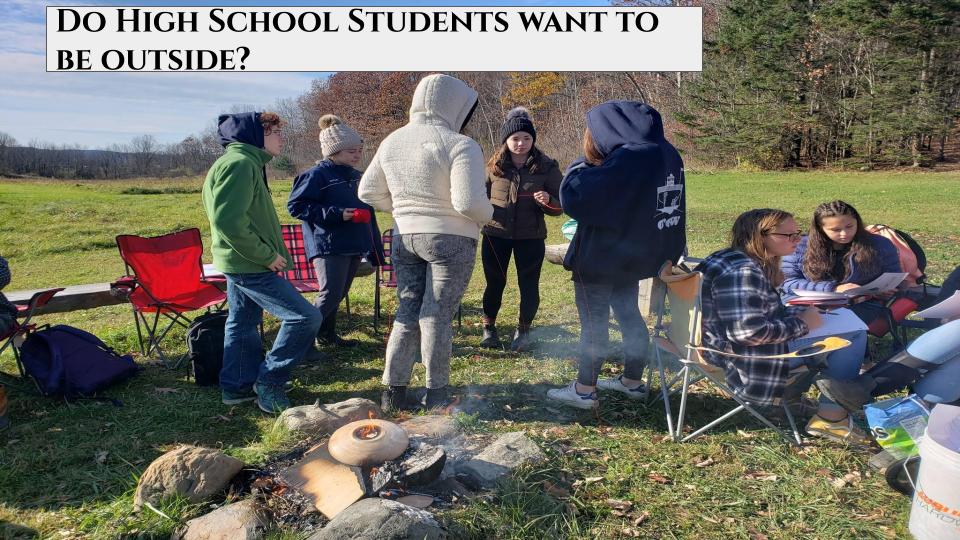
And kids are really hungry, hungry for that.
Even sometimes it’d be like 45 degrees and raining and we’d sit down in our hoophouse and say like, do people want to go for a walk? What do people feel? And always students said let’s go out and be in the elements. One of the great things about working with high school students is that they are so independent.
For us, it’s been the pace of change that students and teachers have been ready and excited to get outside. Before, administrators weren’t quite as ready to get their heads around what that might look like or how to figure out the logistics of that. But I do think that now is a great time to kind of leap on some of the momentum of that. One challenge that comes with that is: how are you doing it intentionally and thoughtfully?
I could say:
Go do this for 35 minutes. I have a rough idea of where you are, and I’ll trust you to come back.
And I felt really safe and comfortable doing that with them.
One of the things that I was unsure of was: are our kids going to enjoy a sit spot where they’re finding this place where they, you know, sit and connect, and go there every day?
That turned out to be silly, because the consistent feedback from students was that they were pleased with outdoor education and that it was too short.
That chance to play and slow down was so important. Did sometimes people fall asleep in their sit spots? Yes. But that also felt important too. A lot of these kids are really busy and really scheduled, so being able to take a nap in a tree was really rejuvenating for them.
I’ve had the benefit of having a chance to plan with place in mind. And I know that many of us are in the situation of suddenly being thrust outside. But I think that designing curriculum that allows you to respond to the place that we’re in, from the very local level to a more global level, to the news, to who we all are as individuals is invaluable.
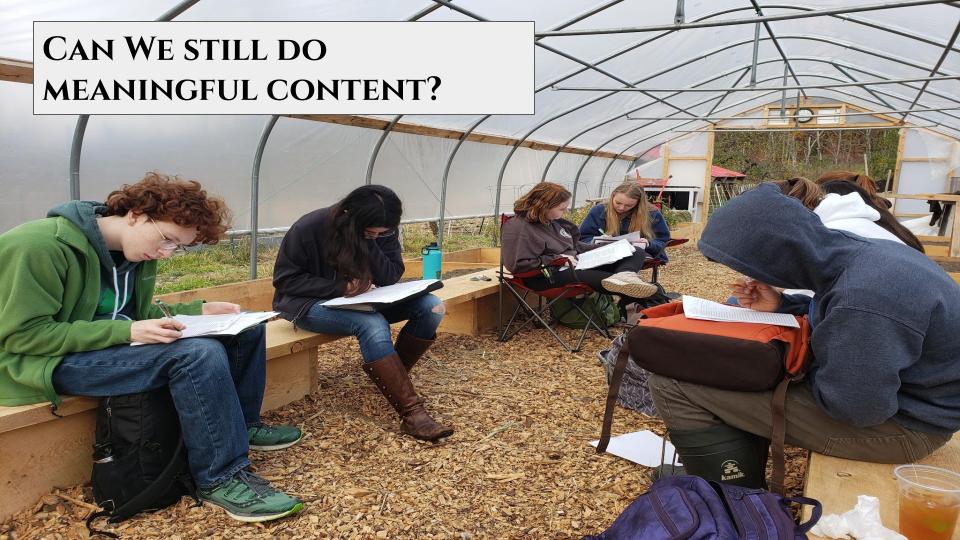
The classes that I teach are an environmental lit class with a focus on the literature of climate change (both fiction and nonfiction and poetry), and a climate justice course that really focuses on environmental racism and creative writing on the trail. Both get kids out and about exploring Vermont.
You can still do research.
You can still do really thoughtful discussion.
And you can still use protocols to really get at some of these ideas.
All our learning targets were really connected to communication.
- How do you clearly communicate about things that you’re passionate about?
- How do you understand the history of what we’re talking about?
What’s been really satisfying, I think, is seeing how rewarding it has been for students. They talk about the rest of their day differently.
I often teach outside for the first block of the day. (We have a four-block schedule). And that introduction to the day has been meaningful. It brings a different kind of calm and focus for the rest of their school work. So I think that’s been huge.
Also just seeing their willingness to make change.
Whether that’s the whole class pledging to be vegetarian for a semester or going to a protest together or doing some writing as a form of activism, I think just that it’s been really relevant for me as a teacher to see students authentically and passionately engaging with the world.
Another great thing about high school students that I found is that there there’s a real willingness to dive in. A real interest in rigorous discussion and a desire for action. They really want to do something. It’s an interesting balance of supporting them and taking action, but also allowing them the space to slow down and just sort of be. To sort of connect with the place around them. I think a really key thing, particularly at the high school level is to, to know that a slow pace doesn’t mean a lack of rigor.
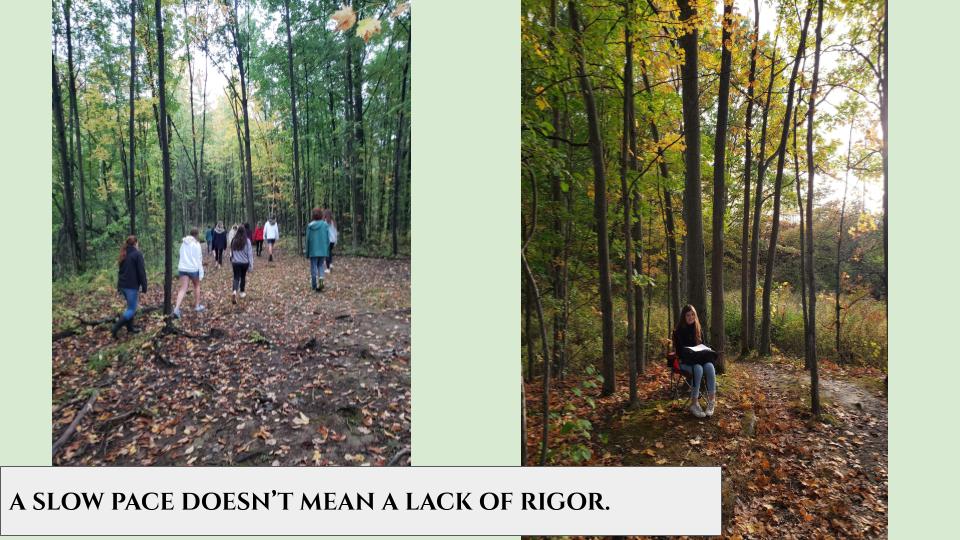
I was really lucky that I got a chance to pilot a course this summer in the time of COVID.
This was an all-day outside summer intensive. And more than ever, that ability to connect, that ability to be outside and able to socially distance and take your mask off and have some great conversations? We brought a bike chariot along to carry our portable handwashing station and some folding chairs that allowed us to be really movable. We started off simply. A five gallon bucket is great for carrying your stuff and sitting on. Plus it’s waterproof.
The thought I want to leave you with is just that I think place-based education has the power to be so transformative.
Keeping it simple and low tech I think is really helpful. And starting small.
I had initially proposed a much bigger interdisciplinary program, but the administration was reluctant. Yet over time, they became more and more supportive and encouraging. And I think the more students were in those classes and able to share that and talk to other students? The more enthusiasm and support we received from the administration.
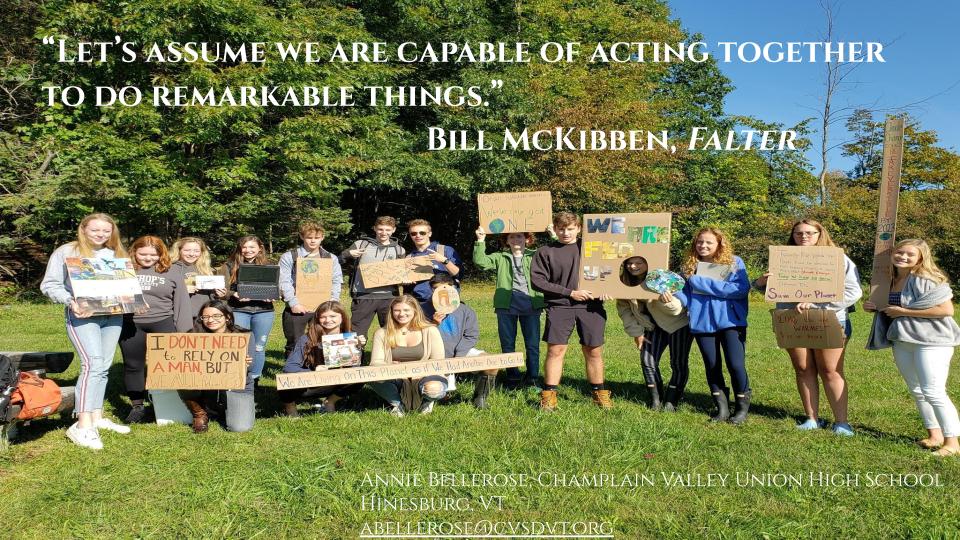
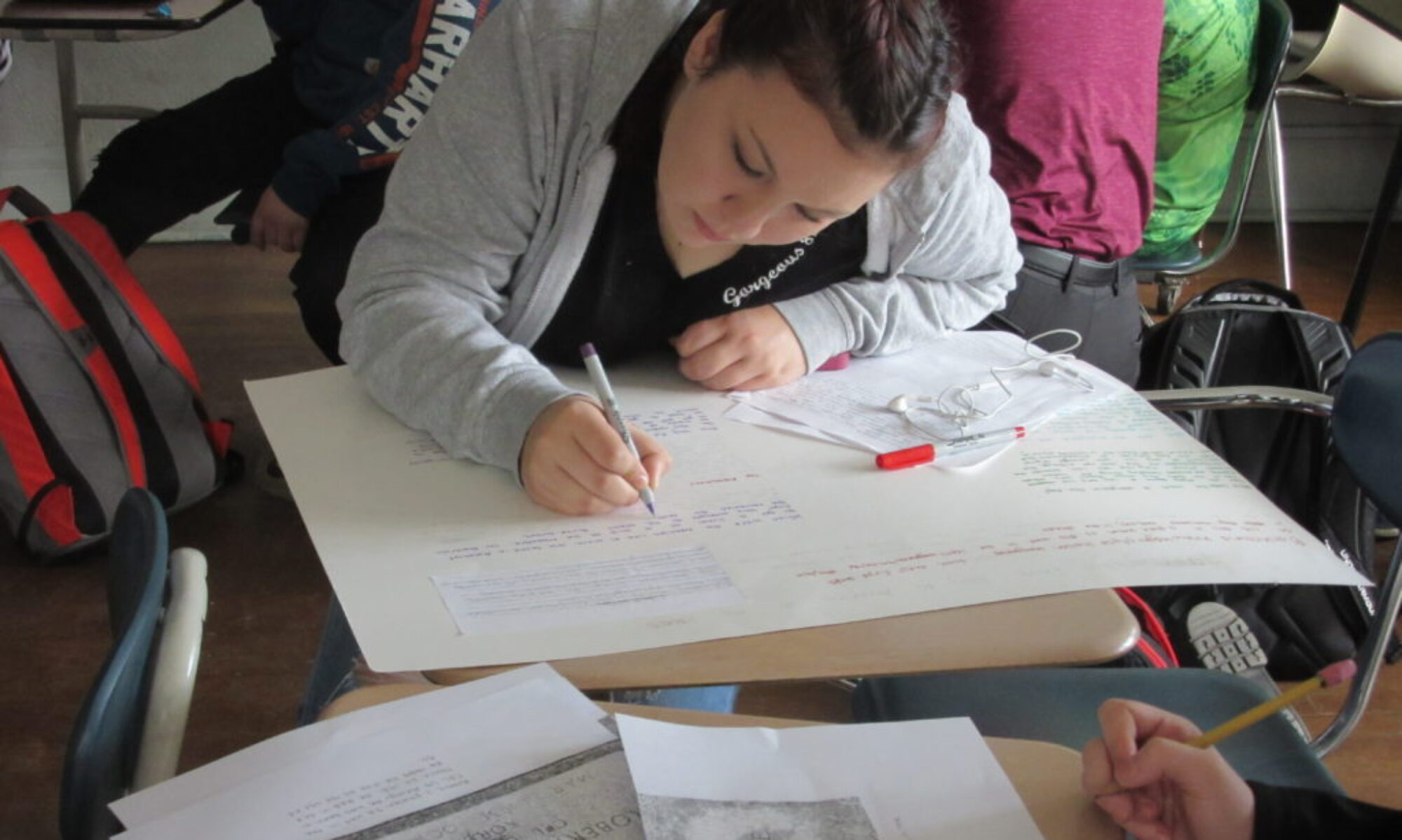

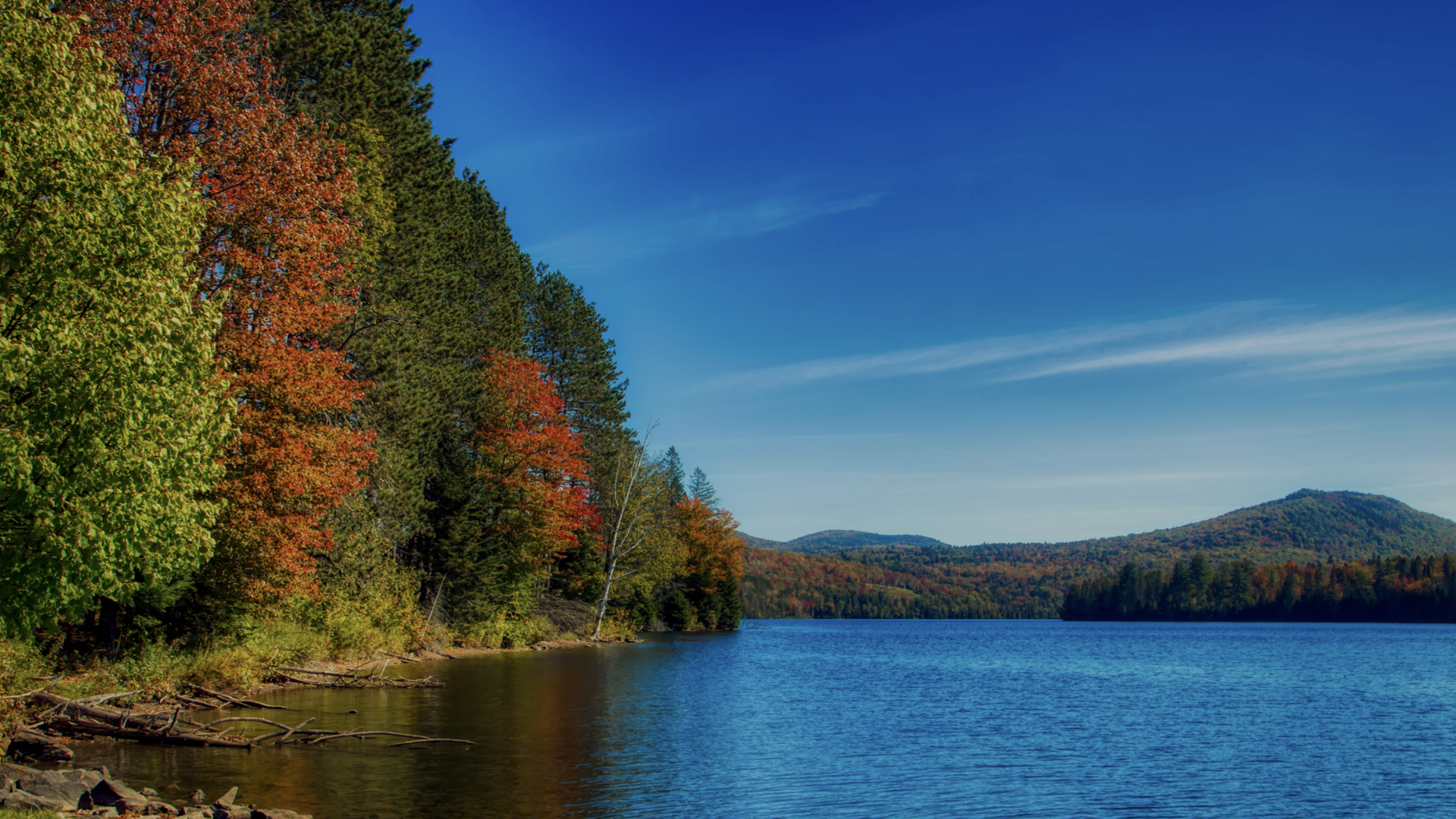
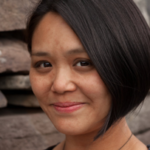

2 Replies to “4 tales of outdoor education in Vermont”
Comments are closed.